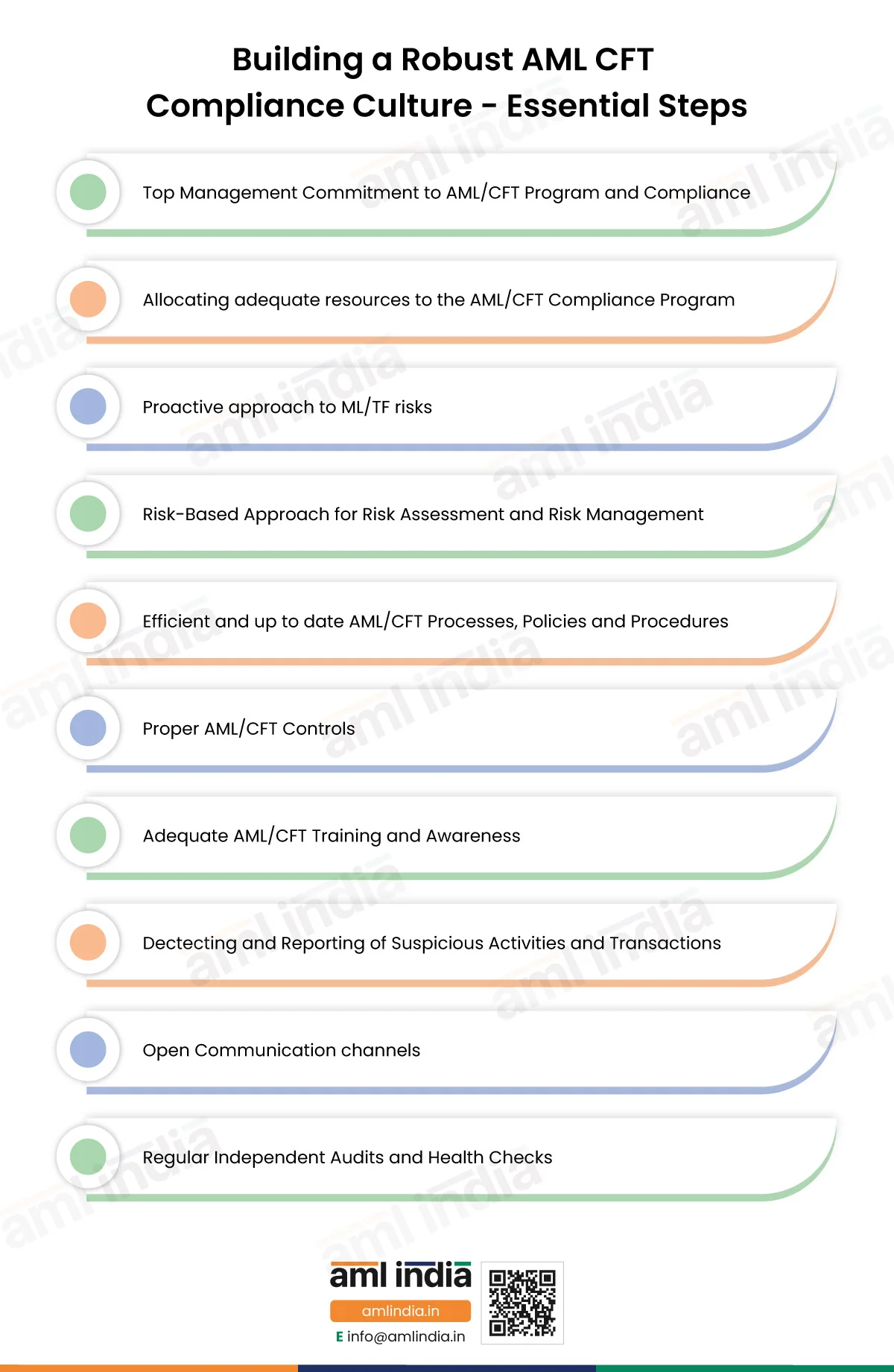
Contact details
Phone No: +91 98248 84900
Email Id: info@amlindia.in
Building a Robust AML/CFT Compliance Culture: Essential Steps
Building a Robust AML/CFT Compliance Culture: Essential Steps
Developing a robust Anti-Money Laundering and Combating the Financing of Terrorism (AML/CFT) compliance culture is extremely important for entities subject to India’s AML/CFT laws and regulations. This infographic describes the various steps involved in building a robust AML/CFT compliance culture. It emphasises the need for a strong AML/CFT compliance culture that not only ensures effective adherence to PMLA, 2002 but also helps in building trust and a positive reputation among customers, investors, and AML/CFT regulators. Further, it also promotes ethical standards such as integrity, accountability and transparency within the entity. These steps involved in building a robust AML/CFT compliance culture are discussed below.
Top Management Commitment to AML/CFT Program and Compliance
Top management must openly commit to ensuring effective AML/CFT compliance. They must actively participate in creating an AML/CFT compliance culture through overseeing the formulation and implementation of the AML/CFT risk assessment, policies, procedures and controls.
Check out: lapses that senior management must avoid to foster AML compliance.
Allocating adequate resources to the AML/CFT Compliance Program
AML/CFT compliance must be seen as an opportunity and not just a cost. A robust AML/CFT compliance program gives long-term dividends such as positive reputation for the entity and lowered or no cost of non-compliance, such as fines and penalties.
Check out: Stepwise Process for Effective Implementation of an AML Program for IFSC Entities
Proactive approach to ML/TF risks
Entities should adopt a proactive approach to AML/CFT compliance, rather than a reactive approach. This means that entities should conduct a proper evaluation of the money laundering, terrorism financing or proliferation financing risks they may face so that they can prepare adequate measures to deal with such risks before they occur. A reactive approach where entity responds when the risks have already occurred increases compliance costs and damages the entity’s reputation.
Risk-Based Approach for Risk Assessment and Risk Management
Entities should adopt a risk-based approach to risk assessment and risk mitigation. This means assessing the money laundering, terrorism financing, or proliferation financing risks the entity may be exposed to based on its type of business, customer base, size, geographies it operates in, etc. On the other hand, a checklist approach would mean standardised AML/CFT risk assessment, resulting in inadequate preparation for the possible risks that an entity may face.
Efficient and up-to-date AML/CFT processes, policies and procedures
AML/CFT processes, policies and procedures must be drafted based on the risks assessed. It should lay down risk mitigation measures. It should be clear and detailed, with no overlap or ambiguity regarding the AML/CFT compliance roles and responsibilities. It should be easily accessible to the stakeholders and regularly updated.
Proper AML/CFT Controls
AML/CFT controls must be viewed as contributing to and enabling AML/CFT risk management rather than restrictive to the entity’s growth. Controls should be regularly tested to ensure their effectiveness.
Adequate AML/CFT training and awareness
AML/CFT program can properly function only if the staff involved in the AML/CFT compliance process understand their role. Therefore, adequate training regarding AML/CFT compliance must be provided at regular intervals to keep the staff up to date regarding their duties and responsibilities.
Also check out: AML Training to the Employees: Strengthening the AML Compliance and Significance of Employees’ contribution to foster AML Compliance
Detecting and Reporting of Suspicious Activities and Transactions
Adequate measures must be in place to promptly detect red flags in customer behaviour or transactions, forwarding them to senior management to take a call on these red flags and subsequently reporting them by filing suspicious transaction report (STR) to the AML/CFT regulatory authorities. This process must be streamlined so that it is conducted in a swift and coordinated manner.
Open Communication channels
To redress and concerns that may crop up, the communication channels from frontline workers to the top management must be clearly laid down, prompt and open. This fosters a culture of deliberation and collaboration to resolve issues.
Regular independent audits and health checks
The typologies of money laundering, terrorism financing and proliferation financing are ever evolving and so are AML/CFT laws and regulations. Frequent AML audits and health checks by independent, qualified and experienced AML/CFT professionals are necessary to ensure that all vulnerabilities that crop up are detected and redressed.
Following the steps discussed above will help in establishing and sustaining a robust AML/CFT compliance culture for entities regulated under India’s AML/CFT laws and regulations. Through these steps, businesses can stay ahead of their AML/CFT regulatory obligations and effectively mitigate the risks associated with money laundering, terrorism financing and proliferation financing, ensuring both legal adherence and enhanced operational integrity.
Important Links
subscribe to newsletter



